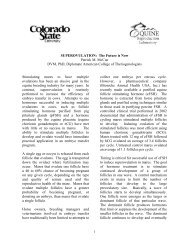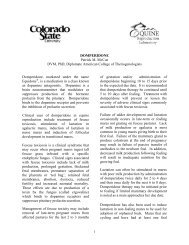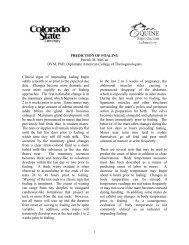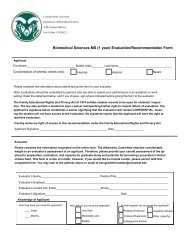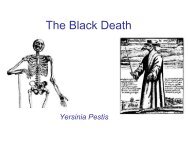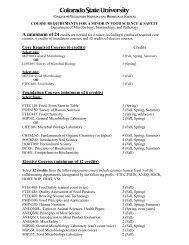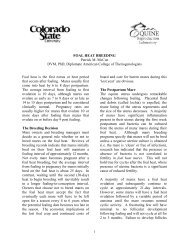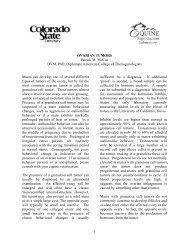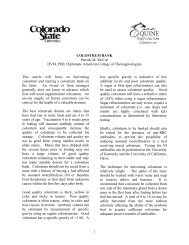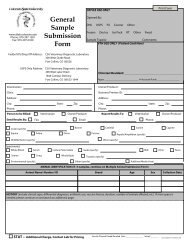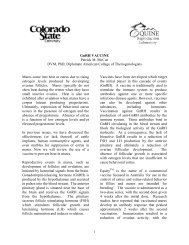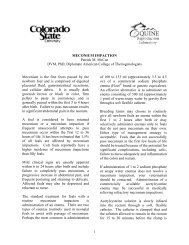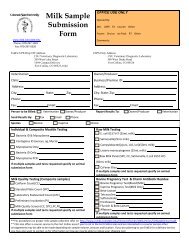LESSONS IN LIGHTS Patrick M. McCue DVM, PhD, Diplomate ...
LESSONS IN LIGHTS Patrick M. McCue DVM, PhD, Diplomate ...
LESSONS IN LIGHTS Patrick M. McCue DVM, PhD, Diplomate ...
You also want an ePaper? Increase the reach of your titles
YUMPU automatically turns print PDFs into web optimized ePapers that Google loves.
<strong>LESSONS</strong> <strong>IN</strong> <strong>LIGHTS</strong><strong>Patrick</strong> M. <strong>McCue</strong><strong>DVM</strong>, <strong>PhD</strong>, <strong>Diplomate</strong> American College of TheriogenologistsThe physiologic or natural breeding seasonof the mare extends from April to October inthe Northern Hemisphere. An increase inday length, or more appropriately, thedecrease in duration of darkness in thespring stimulates ovarian follicular activityin mares. The first ovulation of the year inhorses maintained under natural or ambientphotoperiod conditions is approximatelyMay 1.The most common management strategy foradvancement of the first ovulation of theyear is by use of a stimulatory artificialphotoperiod. Techniques for providing anartificial photoperiod have been describedfor over 40 years. Mares should be putunder lights in late November or earlyDecember to stimulate folliculardevelopment and ovulation by earlyFebruary. In general, approximately 60 to70 days of an artificial photoperiod arerequired to induce ovulation. The mostcommon techniques are to provide 16 hoursof light and allow 8 hours of darkness (i.e.lights on at 7:00 am and lights off at 11:00pm) or to provide approximately 3additional hours of artificial light beginningat dusk. Gradual increases in duration oflight exposure are not required.Incorporation of timing devices to controlthe lighting system is recommended. Thetype of light (i.e. fluorescent orincandescent) is not as important as theintensity of the light. Folliculardevelopment will usually be stimulated ifmares are housed under 10 or more ftcandles of artificial light. Ovarian effectswill be inconsistent or ineffective if lesslight intensity is used. One 200-wattincandescent light bulb in a 12-ft by 12-ftstall is usually sufficient to provide 10 to 12foot-candles of light. Accurate photometersmay be obtained or borrowed from localelectrical contractors to test farm lightprograms.Mares house in stalls with outside runsattached need to be locked in the stalls in thelate afternoon to take advantage of the barnlights. Stimulation will be insufficient ifmares are allowed to wander in and out ofthe stalls in the evening, if the outside run isnot illuminated. Mares that have beenmaintained under lights should be kept inthat same environment until they areconfirmed in foal. Recent studies haveshown that if mares initially housed underlights to stimulate an early ovulation areturned out into a paddock or pasture withonly natural lights in February or earlyMarch may revert to anestrus for 2 monthsor more. Mares turned out later in the springare more likely to continue to cycle. In fact,shorter periods of artificial light stimulation(i.e. 35 days) may be sufficient to stimulatethe onset of follicular development in latewinter or early spring. Exposure of1
seasonally anestrus to a 1- to 2-hour periodof light beginning 9.5 hours after the onsetof darkness has also been reported tostimulate follicular development.The use of an artificial photoperiod does noteliminate the spring transition period. It justmoves the transition period earlier in theyear. Mares will still have prolongedperiods of estrus and waves of folliculardevelopment and regression. However, themares will be ready to breed 2-3 monthsearlier than they would have been otherwise.2



